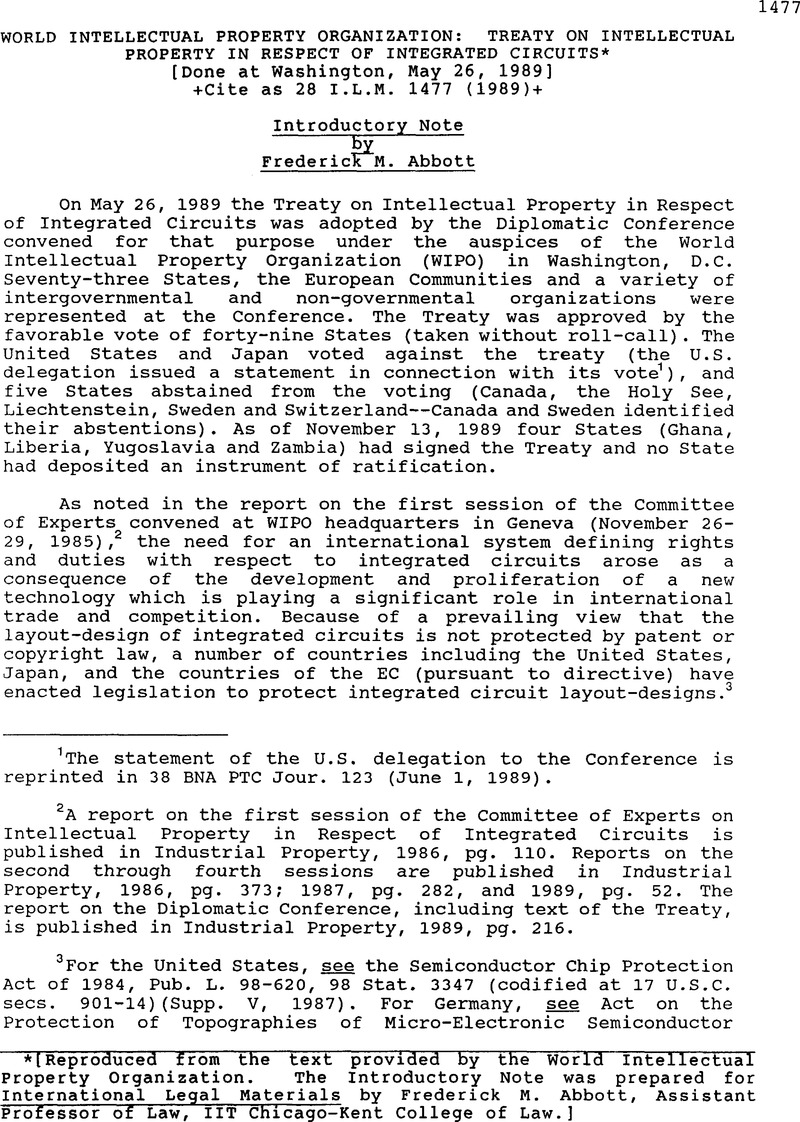Published online by Cambridge University Press: 18 May 2017

[Reproduced from the text provided by the World Intellectual Property Organization. The Introductory Note was prepared for International Legal Materials by Frederick M. Abbott, Assistant Professor of Law, IIT Chicago-Kent College of Law.]
1 The statement of the U.S. delegation to the Conference is reprinted in 38 BNA PTC Jour. 123 (June 1, 1989).
2 A report on the first session of the Committee of Experts on Intellectual Property in Respect of Integrated Circuits is published in Industrial Property, 1986, pg. 110. Reports on the second through fourth sessions are published in Industrial Property, 1986, pg. 373; 1987, pg. 282, and 1989, pg. 52. The report on the Diplomatic Conference, including text of the Treaty, is published in Industrial Property, 1989, pg. 216.
3 For the United States, see the Semiconductor Chip Protection Act of 1984, Pub. L. 98-620, 98 Stat. 3347 (codified at 17 U.S.C. sees. 901-14)(Supp. V, 1987). For Germany, see Act on the Protection of Topographies of Micro-Electronic Semiconductor Products (Oct. 22, 1987), 28 I.L.M.1501 (1989).For Japan, see An Act Concerning the Circuit Layout of a Semiconductor Integrated Circuit, Law No. 4 3 (May 31, 1985) . For the EC Directive, see Council Directive of 16 Dec. 1986 on the Legal Protection of Topographies of Semiconductor Products, 30 O.J. Eur. Comm. (No. L 24) 3 6 (1987) . For a description of the then-current state of protection afforded worldwide for the layout-design of integrated circuits, see WIPO Report to the GATT Trips working group, “Existence, Scope and Form of Generally Accepted and Applied Standards/Norms for the Protection of Intellectual Property”, May 3, 1988 (GATT doc. MTN/GNG/NG11/W/24).
4 17 U.S.C. sees. 902(a)(2) and 914. Protection will be extended to foreign nationals of a country which is party to a treaty protecting mask works to which the U.S. is also a party (sec. 902 (a) (1) (A) (ii) ) . The significance of this provision with respect to the subject Treaty is manifest. Protection under section 9 02 is otherwise conditioned on a favourable finding by the President with respect to the foreign nation, and includes coverage for mask works first commercially exploited in that foreign nation (sec. 902(a) (2)).
5 The GATT intellectual property Framework Agreement is reprinted at 28 Int. L. Mat. 1030-31 (July 1989). The initial U.S. proposal on substantive standards to the GATT TRIPs working group included substantive standards with respect to the protection of integrated circuits (see 4 BNA Int'l Tr. Reptr. 1371 (Nov. 4, 1987) .
6 The fairly general terms of the Treaty make reference to preparatory drafts and reports important. See, in particular. “Draft Treaty, prepared, under Rule (1) of the Draft Rules of Procedure, by the Director General of WIPO” (WIPO doc. IPIC/DC/3, Jan. 31, 1989), which includes both draft treaty provisions and WIPO commentary.
7 See Draft Treaty, supra n. 6, at. pg. 36.
8 Compare sec. 9 07 of the SCPA which requires payment of a reasonable royalty following notice of protection.
9 See, e.g., SCPA, 17 U.S.C. sec. 904.
10 See Draft Treaty, supra n. 6, at pgs. 52-3, for a variety of proposals.
11 Text of the draft dispute resolution proposal of the United States submitted to the Diplomatic Conference is set forth in WIPO doc. IPIC/DC/37 (May 19, 1989). The United States expressed its view of the need for an effective dispute settlement mechanism in another document submitted to the Conference (WIPO doc. IPIC/DC/4 (Feb. 28, 1989)).
12 The United States had proposed that the Director General of WIPO be authorized to appoint panels and establish terms of reference (id.. U.S. proposal).
13 See statement of U.S. delegation (BNA, supra n. 1).
14 The U.S. had proposed that the Assembly be given the power to authorize the suspension (by a party or parties to a dispute) of the application of the Treaty (in whole or in part) to a party which failed to follow its recommendations (U.S. proposal, supra n. 11) .